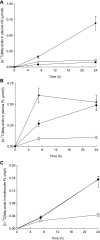Differences in partitioning of meal fatty acids into blood lipid fractions: a comparison of linoleate, oleate, and palmitate
- PMID: 18940935
- PMCID: PMC2636984
- DOI: 10.1152/ajpendo.90730.2008
Differences in partitioning of meal fatty acids into blood lipid fractions: a comparison of linoleate, oleate, and palmitate
Abstract
There has been much interest in the health effects of dietary fat, but few studies have comprehensively compared the acute metabolic fate of specific fatty acids in vivo. We hypothesized that different classes of fatty acids would be variably partitioned in metabolic pathways and that this would become evident over 24 h. We traced the fate of fatty acids using equal amounts of [U-(13)C]linoleate, [U-(13)C]oleate, and [U-(13)C]palmitate given in a test breakfast meal in 12 healthy subjects. There was a tendency for differences in the concentrations of the tracers in plasma chylomicron-triacylglycerol (TG) (oleate > palmitate > linoleate). This pattern remained in plasma nonesterified fatty acid (NEFA) and very low-density lipoprotein (VLDL)-TG (P <or= 0.01 and P <or= 0.02 for [U-(13)C]oleate vs. both [U-(13)C]palmitate and [U-(13)C]linoleate for NEFA and VLDL-TG, respectively). There was significantly more [U-(13)C]linoleate than the other two tracers in plasma cholesteryl ester and phospholipid (PL). Using the values for isotopic enrichment in the different lipid fractions compared with the test meal, we calculated the contribution of meal fatty acids to the respective fractions. At 24 h, 10% of plasma PL-linoleate originated from the breakfast test meal. This was significantly greater than for oleate and palmitate (both 3 +/- 0.3%; P < 0.05). This pattern was also true for erythrocyte PL fatty acids. The marked rapid incorporation of linoleate from a single meal into blood PL fractions may have functional consequences such as maintenance of membrane fluidity and may explain why linoleate is a useful biomarker of dietary intake.
Figures


Similar articles
-
Dietary fatty acids make a rapid and substantial contribution to VLDL-triacylglycerol in the fed state.Am J Physiol Endocrinol Metab. 2007 Mar;292(3):E732-9. doi: 10.1152/ajpendo.00409.2006. Epub 2006 Nov 7. Am J Physiol Endocrinol Metab. 2007. PMID: 17090753 Clinical Trial.
-
Oxidation of dietary linoleate occurs to a greater extent than dietary palmitate in vivo in humans.Clin Nutr. 2021 Mar;40(3):1108-1114. doi: 10.1016/j.clnu.2020.07.013. Epub 2020 Jul 22. Clin Nutr. 2021. PMID: 32753348 Clinical Trial.
-
Adding carbohydrate to a high-fat meal blunts postprandial lipemia in women and reduces meal-derived fatty acids in systemic circulation.Appl Physiol Nutr Metab. 2008 Apr;33(2):315-25. doi: 10.1139/H07-190. Appl Physiol Nutr Metab. 2008. PMID: 18347687
-
Tracing the fate of dietary fatty acids: metabolic studies of postprandial lipaemia in human subjects.Proc Nutr Soc. 2011 Aug;70(3):342-50. doi: 10.1017/S002966511100084X. Proc Nutr Soc. 2011. PMID: 21781361 Review.
-
Problems with essential fatty acids: time for a new paradigm?Prog Lipid Res. 2003 Nov;42(6):544-68. doi: 10.1016/s0163-7827(03)00038-9. Prog Lipid Res. 2003. PMID: 14559071 Review.
Cited by
-
Dietary Impact on Postprandial Lipemia.Front Endocrinol (Lausanne). 2020 Jul 7;11:337. doi: 10.3389/fendo.2020.00337. eCollection 2020. Front Endocrinol (Lausanne). 2020. PMID: 32733374 Free PMC article. Review.
-
Dietary PUFA Preferably Modify Ethanolamine-Containing Glycerophospholipids of the Human Plasma Lipidome.Nutrients. 2022 Jul 26;14(15):3055. doi: 10.3390/nu14153055. Nutrients. 2022. PMID: 35893909 Free PMC article.
-
Twenty-four hour total and dietary fat oxidation in lean, obese and reduced-obese adults with and without a bout of exercise.PLoS One. 2014 Apr 8;9(4):e94181. doi: 10.1371/journal.pone.0094181. eCollection 2014. PLoS One. 2014. PMID: 24714529 Free PMC article.
-
Model-Based Quantification of the Systemic Interplay between Glucose and Fatty Acids in the Postprandial State.PLoS One. 2015 Sep 10;10(9):e0135665. doi: 10.1371/journal.pone.0135665. eCollection 2015. PLoS One. 2015. PMID: 26356502 Free PMC article.
-
High-throughput analysis of total plasma fatty acid composition with direct in situ transesterification.PLoS One. 2010 Aug 9;5(8):e12045. doi: 10.1371/journal.pone.0012045. PLoS One. 2010. PMID: 20711501 Free PMC article.
References
-
- Aarsland A, Wolfe RR. Hepatic secretion of VLDL fatty acids during stimulated lipogenesis in men. J Lipid Res 39: 1280–1286, 1998. - PubMed
-
- Bergouignan A, Schoeller DA, Normand S, Gauquelin-Koch G, Laville M, Shriver T, Desage M, Le Maho Y, Ohshima H, Gharib C, Blanc S. Effect of physical inactivity on the oxidation of saturated and monounsaturated dietary Fatty acids: results of a randomized trial. PLoS Clin Trials 1: e27, 2006. - PMC - PubMed
-
- Bickerton AS, Roberts R, Fielding BA, Hodson L, Blaak EE, Wagenmakers AJ, Gilbert M, Karpe F, Frayn KN. Preferential uptake of dietary fatty acids in adipose tissue and muscle in the postprandial period. Diabetes 56: 168–176, 2007. - PubMed
-
- Brossard N, Croset M, Normand S, Pousin J, Lecerf J, Laville M, Tayot JL, Lagarde M. Human plasma albumin transports [13C]docosahexaenoic acid in two lipid forms to blood cells. J Lipid Res 38: 1571–1582, 1997. - PubMed
Publication types
MeSH terms
Substances
Grants and funding
LinkOut - more resources
Full Text Sources
Medical
Miscellaneous

